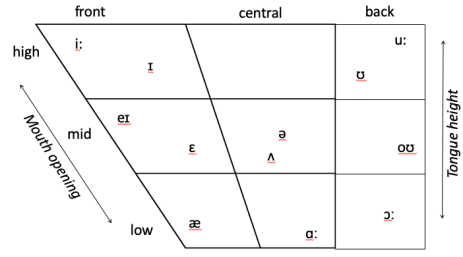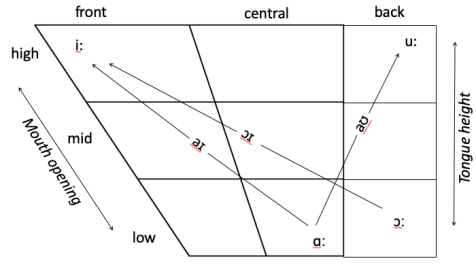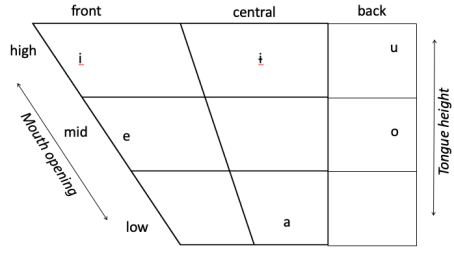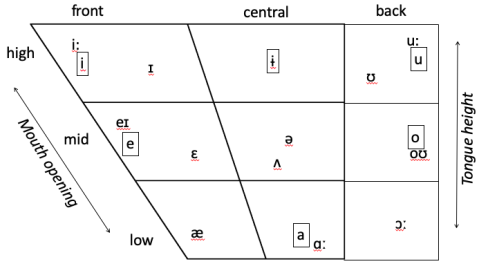In this article I will look into the North American (NAE) and Russian Vowel Systems, describe them and highlight the differences and common problems of Russian speakers while gaining the NAE accent. In the conclusion I will provide guidelines that teachers might take into consideration when teaching pronunciation.
I have been teaching English for about three years in Russia, the last six months I have been working only with adults and I have noticed some repeated mistakes of my students in pronunciation. Unfortunately, during regular classes it if difficult to devote time to pronunciation and students do not have enough time to practice sounds. As a result, their listening and speaking skills are affected by the lack of knowledge about articulation of sounds. Right now, I offer you to discover some crucial vowel characteristics of both languages.
Overview of the North American English vowel system
According to Marianne Celce-Muricia and her book Teaching Pronunciation, there are fourteen stressed vowels in the North American English Vowel System. Furthermore, eleven of them are either simple vowels (vowels without an accompanying glide movement, as in bet /ɛ/) or vowels with an adjacent glide (vowels accompanied by /y/ or /w/. as in bait /eɪ/ or boat /oʊ/) and the remaining three are diphthongs (vowels consisting of a vowel sound followed by a nonadjacent glide within the same syllable, as in boy /ɔɪ/, buy /aɪ/ and blouse /aʊ/). [1] However, there is one more vowel — schwa /ə/ but it is always unstressed. Nevertheless, it is considered to be the most frequently occurring vowel in English. Thus, in this article I will take the statement that there are 15 vowels in NAE as a basis. (Table 1)
Table 1
Vowels of the NAE
|
№ |
Sound |
Example |
№ |
Sound |
Example |
|
1 |
/i:/ |
read |
9 |
/ɔː/ |
law |
|
2 |
/ɪ/ |
sister |
10 |
/oʊ/ |
slow |
|
3 |
/eɪ/ |
late |
11 |
/ʊ/ |
foot |
|
4 |
/ɛ/ |
get |
12 |
/u:/ |
move |
|
5 |
/æ/ |
sap |
13 |
/aɪ/ |
time |
|
6 |
/ɑː/ |
hot |
14 |
/aʊ/ |
house |
|
7 |
/ʌ/ |
mud |
15 |
/ɔɪ/ |
choice |
|
8 |
/ə/ |
a bout |
Since there is no obstruction while producing vowels, different NAE vowel sounds might be distinguished from each other by four characteristics: tongue height, frontness/backness of the tongue, tenseness/laxness and lip rounding [1]. Three first features are presented in the NAE vowel quadrant (Figure 1).

Fig. 1. The NAE vowel quadrant
Let’s take a closer look at each characteristic.
Tongue height
As we can see there are 4 high vowels, /i:/ as in beat, /ɪ/ as in bit, /u:/ as in boot and /ʊ/ as in book. They are called so because they are made with the tongue raised above its rest position. Then mid vowels follow such as /eɪ/ as in bait, /ɛ/ as in bet, /ʌ/ as in but, and /oʊ/ as in boat. The tongue is neither high or low in the mouth. The last but not least are low vowels such as /æ/ as in bat, /ɔː/ as in bought, and /ɑː/ as in pot. The tongue is below its rest position. It should be noted though that many American speakers pronounce words ‘bought’ and ‘pot’ with the same vowel, the /ɑː/.
Frontness/backness of the tongue
Now we have to compare vowels in rows. The vowels as /i:/, /ɪ/, /eɪ/, /ɛ/ and /æ/ are front vowels sounds. It means that the front part of the tongue works more while those vowels are pronounced. Opposite of them are back vowels such as /u:/, /ʊ/, /oʊ/, /ɔː/. Furthermore, there are also vowels in English made with neither the front or the back part of the tongue. These are referred to as central vowels, the position of the tongue is very close to where it usually rests. Here we have /ʌ/, /ɑː/ and /ə/. [3] Thus, we can combine these two characteristics and determine vowels as high/mid/low/ front/mid central/back vowels (Table 2).
Table 2
Classification of the NAE vowels
|
front |
central |
back |
|
|
high |
Beat /i:/ Bit /ɪ/ |
Book /u:/ Book /ʊ/ |
|
|
mid |
Bait /eɪ/ Bet /ɛ/ |
M a chine /ə/ But /ʌ/ |
Boat /oʊ/ |
|
low |
Bat /æ/ |
Pot /ɑː/ |
Bought /ɔː/ |
Tenseness/laxness
We also differ vowels according to the muscle tension in the mouth. The tense vowels /i:/, /eɪ/, /ɑː/, /ɔː/, /oʊ/, /u:/ are articulated with more tension than lax vowels /ɪ/, /ɛ/, /æ/, /ʌ/, /ə/, and /ʊ/. The tense vowels are pronounced longer and also usually accompanied by a glide. This phenomenon is called diphthongization and means that there is movement of the tongue during the pronunciation of each of the tense vowels.
Another difference is that tense vowels occur in both stressed open syllables, for example as in ‘tea’ and in stressed closed syllables, as in ‘team’, whereas lax vowels occur only in closed syllables such as ‘him’ and never in open syllables.
Lip rounding
Our last characteristic is lip position which can be described as rounded or spread, or neutral. There are four vowels made with lip rounding: /u:/, /ʊ/, /oʊ/, and /ɔː/. Moreover, Marianne Celce-Murcia claims that sounds /oʊ/ and /u:/ have extreme rounding and /i:/ has extreme spreading of lips. Also, the lips are more spread for the front vowels and more rounded for the back vowels.
The diphthongs
In NAE there are 3 diphthongs: /ɔɪ/, /aɪ/ and /aʊ/. The main feature of diphthongs (or complex vowels) is that they consist of two nonadjacent sounds and their articulation requires a broad gliding movement from one point to the other (Figure 2). It is notable that tense vowels are not considered to be diphthongs because there is less tongue movement comparing with the latest [1, 2].

Fig. 2. The NAE diphthongs
Overview of the Russian vowel system
The Russian language has six vowels: /a/, /o/, /u/, / ɨ /, /i/, /e/ in the stressed position between hard consonants or in the beginning word position [4]. All vowels are presented in the table 3.
Table 3
Russian vowels
|
№ |
Sound |
Example in Russian |
Transcription |
Translation |
|
1 |
/i/ |
иск |
/isk/ |
lawsuit |
|
2 |
/e/ |
э тот |
/’etət/ |
this |
|
3 |
/ ɨ / |
ты |
/tɨ/ |
you |
|
4 |
/a/ |
п а лка |
/’palkə/ |
stick |
|
5 |
/u/ |
у гол |
/’ugəl/ |
corner |
|
6 |
/o/ |
дом |
/dom/ |
house |
Russian vowel sounds are distinguished from each other by four characteristics: tongue height, frontness/backness of the tongue, lip rounding, and softness/hardness of consonants around the vowel. The first two features are depicted in the picture (Figure 3)

Fig. 3. Russian vowel quadrant
Tongue height, frontness/backness of the tongue
The Russian language has 3 high sounds /i/, / ɨ /, /u/, two mid sounds /e/ and /o/ and just one low sound /a/. Regarding to the horizontal position of the tongue there are two front vowels /i/, /e/, two central vowels / ɨ / and /a/ and two back vowels /u/ and /o/. These characteristics with example words are presented in the table 4.
Table 4
Classification of Russian vowels
|
front |
central |
back |
|
|
high |
Ил (silt) /i/ |
Сыр (cheese) / ɨ / |
У ровень (level) /u/ |
|
mid |
Мэр (mayor) /e/ |
Гор о х (pea) /o/ |
|
|
low |
М а ма (mother) /a/ |
Lip rounding
Furthermore, the presence or absence of lip articulation is important for Russian vowels. Labial articulation increases the volume of the resonator and describes /o/ and /u/ phonemes after soft and hard consonants. When pronouncing /o/ sound, the lips should be rounded while pronouncing /u/, not only are lips rounded but also protruded forming a narrow outlet. Other four vowels lack both lip rounding and spreading.
Softness/hardness of consonants around the vowel
In the Russian language articulation of vowel sounds depends on softness or hardness of consonant sounds around them. Vowels in a position between hard or soft consonants appear in the forms of the same phoneme’s variation. For example, a pair of words ‘мал’ (small) — /ˈmal/ vs. ‘мял’ (crumpled) — /m’al/. Those words differ in the hard and the soft phoneme /m/, whereas, the vowel /a/ is realized in the form of [a] after the hard consonant and [‘a] after the soft one.
The heterogeneity of vowels is most in the phonemes /‘o/, /‘e/, /‘a/. A feature of vowels after soft consonants is the shift of articulation forward and heterogeneity of sounds. After soft consonants the beginning moment of articulation is the rise of the middle part of the tongue giving the i — type glide sound (in the phoneme /o/ this glide merges with the beginning sound of /u/. Then the tongue reaches that degree of elevation that is characteristic of the phonemes /a/, /o/, /e/, /u/, and /i/. This action changes the size of oral cavity creating specific timbre. The most heterogenic vowels are those that are located between two soft consonants since the i — type glide appears both at the beginning and at the end of the vowel sound.
The acoustic effect of the advanced articulation of vowels after soft consonants is well understood by Russian speakers. Whereas, the difference in articulation of vowels between two soft consonants are picked up by ear by native speakers only after a long training [4, 5, 6].
Describing differences
1. Number of vowels
As it was presented in the two first parts of the article there is a tremendous gap in number of vowels between two phonetic systems, where NAE has 15 vowels and Russian has only 6. Moreover, the Russian language lack diphthongs but both languages have glides. In NAE they are /u:/ and /i:/ followed by the semi-vowel /w/ and /y/ accordingly. In Russian they are /o/, /e/ and /a/ if they are between soft consonants.
2. Placement
The placement of sounds is also different even though there are relatively similar sounds such as /u:/, /ʊ/ and /u/, /’u/, /ɛ/ and /e/, /i:/, /ɪ/ and /i/, /ʌ/, /ɑː/ and /a/, /ɔː/ and /o/. The comparison of two vowel quadrants is presented in the picture. Russian vowels are outlined. (Figure 4)

Fig. 4. The comparison of the NAE and Russian vowel quadrants
In the Russian language there is a balanced arrangement of vowels in the oral cavity whereas in North American English the congestion of the rear zone of articulation is observed. Furthermore, Russian vowels are more fronted and they are more closed. This is particularly true for high vowels such as /i/, /ɨ/. /u/ which are pronounced with the minimal mouth opening. NAE vowels are more open. First of all, this applies to low vowels the openness of which is farthest from the average. Another thing we must consider is that Russian vowels /o/ and /u/ are labialized while in American English the rounding of /ɔː/ and /u:/ is less significant. Also, for English vowels the position of the tongue is more drawn away from the teeth and the tip of the tongue is curved upward not touching the palate. Whereas, in Russian the tip of the tongue rests on the lower teeth and the front and middle parts of the tongue is lifted to the palate [5, 7].
3. Reduction
As it was mentioned, the reduced sound schwa /ə/ takes its proud place in the NAE phonetic system, furthermore, if schwa is followed by /r/ it turns into /ɚ/, or r-colored schwa. Schwa is a mid-central and the most frequently occurring vowel in English. It happens to appear instead of the unstressed a, e, i, o, and u letters, for instance in such words as atlas, college, promise, purpose, lettuce. However, besides /ə/ and /ɚ/, there are other reduced vowel sounds — /ɪ/, /i/, /o/, and /u/ like in words music, city, hotel, menu accordingly. In NAE reduction occurs in two cases. First, when a vowel is in unstressed syllable in a multisyllable word (‘ a llow’, ‘foc u s’) and second, when monosyllabic words have both a stressed and a reduced form (‘a’ — /ey/ and /ə/).
Nevertheless, in the Russian language, reduction depends on the unstressed syllable position in relation to the stressed syllable. Based on this, there are two degrees of vowel reduction — weaker (the first degree reduction) and stronger (the second degree reduction). Weaker reduction includes the first pre-stressed syllable and any open beginning syllable. For example, like in words с а ма / sɐˈma/ — herself and о на / ɐˈna/ — she. Stronger reduction includes vowels in second and third pre-syllable syllables and in all post-stressed syllables. For instance, пр е п о давател и / prʲɪpədɐˈvatʲɪlʲɪ/ — teachers.
In both Russian and English there are quantitative and qualitative types of reduction. In quantitative reduction vowels are shortened by length and tenseness in the unstressed position. In Russian, for example, in the word ‘cухой’ /suxoi/- dry the phoneme /u/ undergoes the reduction. The same happens in English, in the word ‘he’ /hi/. Furthermore, in qualitative reduction vowels in unstressed forms undergo both quantitative and qualitative reduction. It means that vowels lose their distinct sound and change their timbre. In Russian such vowels as /o/, /a/ /e/ are undergone such changes in words в о дяной / vədʲɪˈnoj/, с а довод / sədɐˈvot/, ж е ребёнок / ʐɨrʲɪˈbʲɵnək/. In English, the words ‘can’/ kən/ and ‘to’ /tʊ/ might serve as an example. As we can see in NAE both long and short vowels are affected.
The relative degree of reduction of unstressed syllables is different , though. In Russian reduction intensifies in syllables which are further away from the stress. The stressed syllable is the longest and the most intense. The first pre-stressed syllable is a bit shorter and others, beside the first open syllable, are even shorter and weaker. In North American English vowels in the first pre-stressed syllable and the first post-stressed syllable are the weakest and the shortest. But in syllables which are further away from the stress vowels become more tense and longer [4]. The approximate patterns of reduction of both languages are shown in the picture below. (Figure 5)
|
Russian |
||||||||||
|
a |
t |
a |
t |
a |
t |
a |
t |
a |
t |
a |
|
2 |
1 |
2 |
3 |
1 |
1 |
|||||
|
NAE |
||||||||||
|
t |
a |
t |
a |
t |
a |
t |
a |
t |
a |
|
|
2 |
1 |
3 |
1 |
2 |
||||||
Fig. 5. The NAE and Russian patterns of reduction
4. Secondary stress
One of the main characteristics of word stress in English is that it can occur on almost any syllable, depending in part on the origin of the word. Besides having the strong and the weak stress, the English language possesses the secondary stress which is absent in Russian. [1] It means that those syllables are still quite clear, but they are not as long, and loud in pitch as the strong stressed syllable. The vowels that receive the secondary stress are a bit shorter, lower in volume and pitch. For example, it might happen in two-syllable words such as athlete, contact, or boycott. Because the second syllable receives some stress, the vowels are not reduced to schwas. Also, the same occurs in three-syllable words as acrobat, celebrate, and telephone. However, in this case the first syllable receives the strong stress, the second syllable is unstressed and the last syllable receives the secondary stress. Thus, only the vowel in unstressed syllable reduced to schwa. [2]
As it was mentioned, there is no such a term as the secondary stress in the Russian language. In every word in Russian there is just one main stress. Other syllables are considered as unstressed. The stressed syllables in Russian are louder and longer.
Conclusion
The present analysis of the disparities between the two vowel systems makes it reasonable to expect that Russian speakers will face problems mastering the more differentiated vowel system of NAE. What are some common challenges? Russian speakers generally have difficulty producing English vowel distinctions. For instance, the tense/lax vowel pairs such as /i:/ vs. /ɪ/, /u:/ vs. /ʊ/. In the Russian language there are two similar sounds /i/ and /u/ but there are no such terms as laxness or tenseness. As a result, students tend to pronounce Russian equivalents instead of four different English vowels. Furthermore, the low front vowel /æ/ and the central vowels /ʌ/ and /ə/ do not exist in Russian. In this case it is more likely that student would use /ɛ/ and /a/ accordingly. Besides that, the English vowel /ɑː/ is further back than the low Russian vowel /a/, therefore, when pronouncing, Russians change the quality of the sound and are prone to not open the mouth wide enough. Moreover, since Russians have only two front vowels and two back vowels against five English front vowels and fore English back vowels it gets extremely difficult to pick the nuances between the tongue positions.
Regarding to reduction and the secondary stress, the schwa is often overpronounced to /a/ with the jaw dropping or /u/ with the lip rounding. For example, Russians would pronounce the word ‘blood’ more like /blad/ instead of /blʌd/ and the word ‘circus’ like /ˈsɝː.kus/ instead of /ˈsɝː.kəs/. Moreover, since Russian speakers use only one main stress in words it may cause difficulties in pronunciation of English words with the secondary stress. More likely Russian speakers will try to reduce the vowels or change them into the closest native equivalent where there should be the full-length vowels. For instance, the word ‘acrobat’ might sound more like /ˈæk.rə.bət / or /ˈæk.rə.bat / instead of /ˈæk.rə.bæt/.
To help students to obtain accuracy of pronunciation, it is recommendable to present information of the articulation of individual vowels and compare them with the most similar sounds in the Russian language. After that students might practice minimal pair words, collocations and sentences. Such practice will help students gain control over segmental contrasts. To help them develop their listening skills , it is offered to let them listen recordings with targeted sounds and identify the right one. A good way of the controlled practice phase is to choose a subject category and elicit words containing the targeted vowels. Another activity that lends itself well to the controlled practice involves dialogs containing words with the contrasting vowel sounds. First, students should locate all the words containing a certain sound and then practice dialogs in pairs. At the final communicative stage, students could generate utterances of their own. Such comprehensive approach that is discussed here should enable teachers to reach those goals with their students.
References:
- Marianne Celce-Muricia Teaching Pronunciation, 2006, Chapters 4, 5
- Peter Avery Teaching American English Pronunciation, 2002, Chapters 2, 5, 7
- Paul Carley American English Phonetics and Pronunciation Practice, 2020, Chapter 5, 8
- Акишина А. А., Барановская С. А. Русская фонетика на фоне общей , 2019, Chapter 5
- Одинцова И. В. Звуки. Ритмика. Интонация , 2017, Appendix III
- Гиржева Г. Н. Фонетика современного русского языка, 2015, Chapter 8
- Зырянова А. В. Теоретическая фонетика английского языка, 2016, Chapter 2







